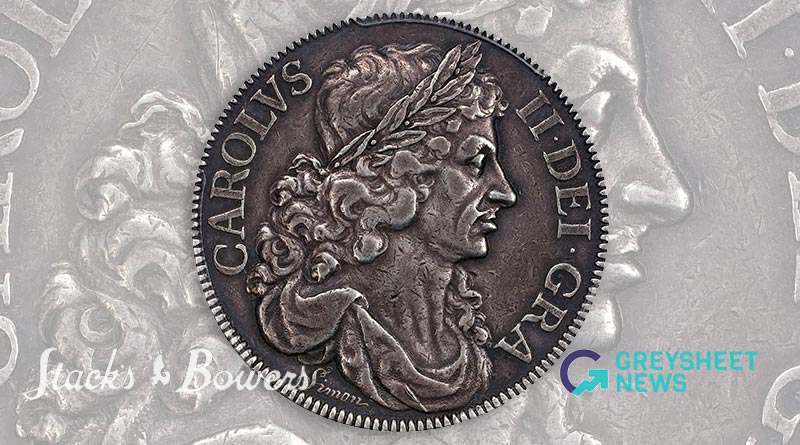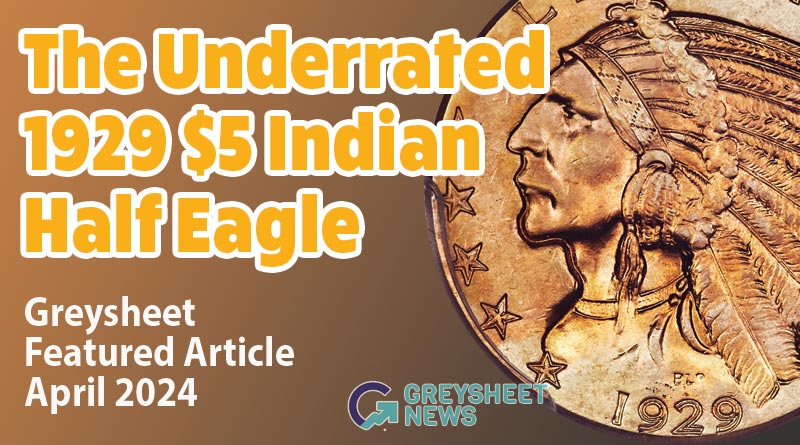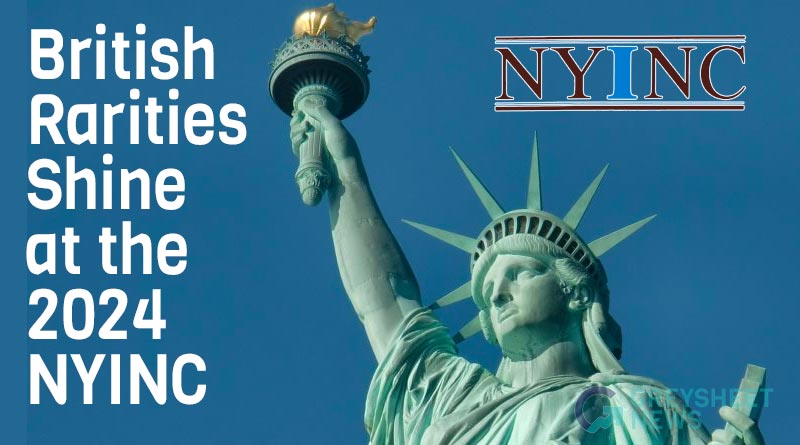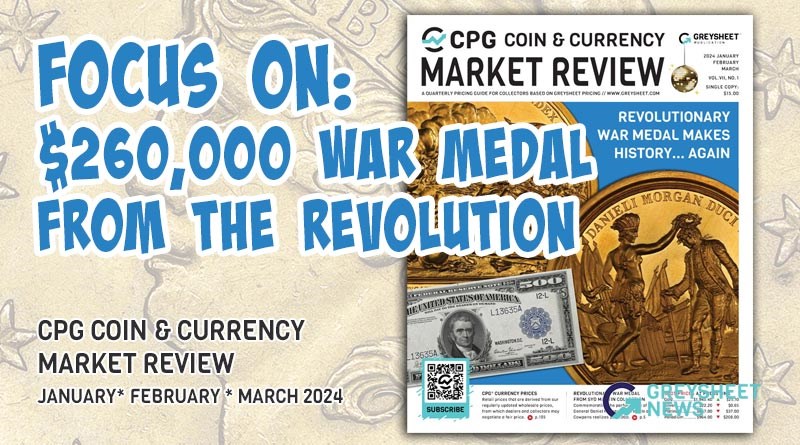British Petition Crowns Distinguish ANA Convention
Heritage is planning to auction an NGC graded MS62 Petition Crown at the New York International Convention in January 2024. Pictures are already posted on the Heritage website.
Amazingly, there were three Charles II Petition Crowns present at the annual ANA Convention, which was held this year in Pittsburgh during August. These are large, British silver patterns dated 1663. Although a large percentage of the collectors and dealers in attendance were focused upon U.S. coins and related items, this ANA Convention was markedly unusual because most of the really famous numismatic items there were British coins and patterns.
One of the all-time greatest collections of British coins, that of “The Tyrant,” was featured in a marvelous and very sophisticated display on the bourse floor. In addition, there were British specialists from the U.S. and leading dealers from Great Britain showing impressive inventories. Furthermore, both Heritage and Stack’s Bowers had especially important runs of British rarities in their respective post-ANA auctions, which were shown in lot viewing sessions at the convention. This was the first ANA Convention where British items were the most newsworthy.
The most famous British numismatic items that were struck in silver are the 1663 Petition and Reddite Crowns, which feature a portrait of King Charles II. These are heavier than U.S. silver dollars, though Petition Crowns are really patterns, not coins. Petition Crowns feature an inscription on the edge that was directed towards King Charles II, and Reddite Crowns were made later from the same pair of dies. Reddite Crowns feature a more general inscription on the edge. The Petition Crowns established a link between Thomas Simon, the most accomplished and famous numismatic engraver of the era, and the king himself.
Around fifteen Petition Crowns are known to exist. Several are in museums. It was astonishing that three privately owned Petition Crowns were at the ANA convention in Pittsburgh, though not one was within a few yards of another. It is very unlikely that three Petition Crowns were ever before in the same building in the United States at the same time.
Coin enthusiasts have been talking about Petition Crowns for more than 350 years! In the early 1660s, numismatists, nobles and the general public were all eagerly anticipating the upcoming coins of Charles II, of which silver crowns would be the most important. Like Spanish Milled Dollars (eight reales coins of the Spanish Empire) and talers of German-speaking societies, a silver British Crown was politically symbolic, especially abroad, and crowns were often used in international trade.
The Petition Crown is called the Petition Crown because Thomas Simon petitioned for the adoption of his design with a message on the edge of the Petition Crowns. Although this message is in English, the grammar and styles of the 1600s are different from those of the twenty-first century.
For an article of mine that was published in 2018, I converted Simon’s original plea into a message that is understandable now:
‘Thomas Simon most humbly prays that your majesty will compare this pattern piece for him with that of the Dutchman. If this piece is more truly drawn and embossed, more graceful, more accurately engraved, and fully ordered, than his piece, relieve him of his position.’
Thomas Simon employed the term ‘Dutchman’ to refer to John Roettiers, who was recently hired as an engraver at the Royal Mint in London, and Simon was asking the king to fire Roettiers if the king found Simon’s proposed silver crown (something like a silver dollar) to be superior in every respect to Roettiers’ silver crown pattern. This last name, “Roettiers,” was sometimes spelled without an ‘s’ at the end.
From 1645 to 1649, Simon was co-chief engraver at the primary mint of England, which was the Tower Mint in London, and Simon was chief engraver during the 1650s, while the rebels ruled England. Simon was the lead engraver of coins, medals, and seals for the rebels, including Parliamentarians and followers of Oliver Cromwell, who had defeated the royalist forces of King Charles I (father of Charles II) to win the English Civil War.
In the 1660s, there was a good chance that John Roettiers was selected as a lead engraver because of his political connection to King Charles II rather than due to Roettiers’ qualifications. Thomas Simon emphasized his skills, partly to deflect attention from his past involvement with the rebels, the Parliamentarians and then Oliver Cromwell’s government.
In his petition, by ‘emboss,’ Simon is referring to more than his ability to engrave raised design elements. Simon was proclaiming his ability to adorn, embellish and elegantly stylize intricate details of a coin or medal design.
Before King Charles II even saw a Petition Crown, the design by Roettiers was probably already selected. Although apparently involved in a design competition, Simon was really making a statement, implying that talent and qualifications should supersede politics. Artisans, politicians, and numismatists were then aware of Simon’s exceptional career in engraving coins, medals and seals.
Simon’s Petition Crowns of 1663 have captured the attention and imagination of collectors and historians ever since. While the Petition Crowns loudly featured a message in English from Simon to the king, the Reddite Crowns were directed at a noble audience with an inscription in Latin that signaled Simon’s allegiance to the restored monarchy and the regime of Charles II.
Unsurprisingly, there was a Petition Crown in “The Tyrant Collection,” the best collection of British coins ever assembled in the United States. That 1663 pattern was PCGS certified as SP53 before it realized $649,000 in an auction held on January 10, 2018, which was conducted by a coalition led by the Goldbergs at a New York International Convention. That Petition Crown was consigned in 2017 through Sovereign Rarities, a member of the coalition. Of course, it was part of the display of ‘The Tyrant Collection’ of British coins at the ANA Convention in Pittsburgh in 2023.
In this same incredible display, there was the rarest and possibly most valuable, regular issue British gold coin, the Double Leopard of 1344. As far as I know, this is the only privately-owned Double Leopard, and was the first relatively large gold coin of England.
In 1344, the denomination of the Double Leopard, 72 pence, did not fit well in the English monetary system, and was soon replaced by the Noble, 80 pence. The Noble was denominated as one-third of a pound (240 pence) and as half a Mark (160 pence); a Noble was thus much more useful in circulation than a Double Leopard. A silver crown, which was not introduced in England until the reign of Edward VI, was denominated as 60 pence (5 shillings), one-fourth of a pound. Important vintage British coins can be seen prior to pertinent Goldbergs, Heritage and Stack’s Bowers auctions.
At the Pittsburgh World’s Fair of Money in August, in the lot viewing room for Stack’s Bowers auctions, a PCGS certified SP45 Petition Crown was available for examination. It was later purchased by a West Coast collector for $228,000.
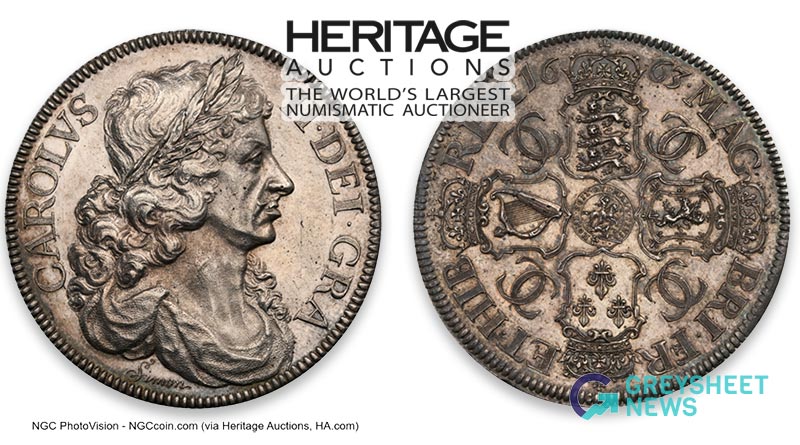
Heritage is planning to auction this NGC graded MS62 Petition Crown at the New York International Convention in January 202.
On the convention floor, dealer Greg Holloway had an astonishing display of British rarities at his tables. Holloway has a PCGS certified SP63 Petition Crown, which might very well be the finest known. I wish to thank Greg for allowing me to closely inspect this exceptional pattern on multiple occasions and show it to others.
Petition Crowns are not business strikes; they are clearly specially made and structurally impressive for the time period. For more than fifteen years, I have been fascinated by specially made British coins and patterns from the 1600s and 1700s.
I waited a few weeks before writing this report to include breaking news. Heritage is planning to auction an NGC graded MS62 Petition Crown at the New York International Convention in January 2024.
Copyright ©2023 Greg Reynolds
Insightful10@gmail.com

Download the Greysheet app for access to pricing, news, events and your subscriptions.
Subscribe Now.
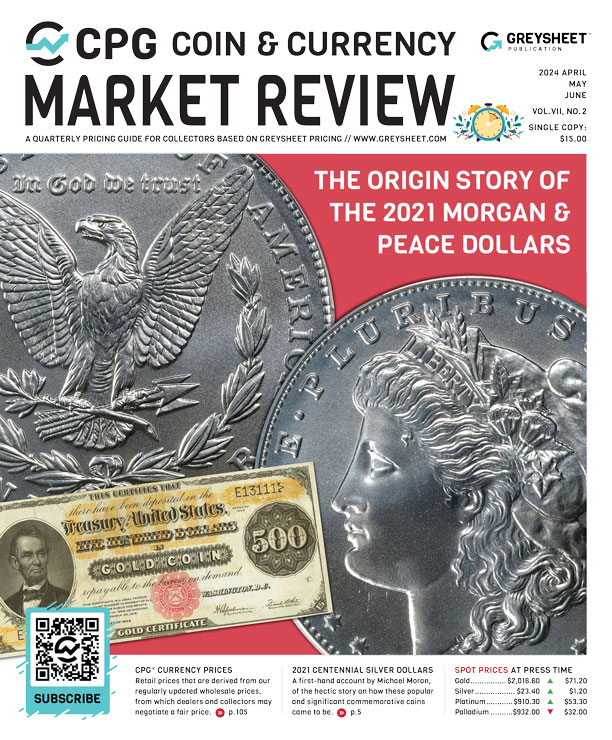
Subscribe to CPG© Coin & Currency Market Review for the industry's most respected pricing and to read more articles just like this.
Source: Greg Reynolds


